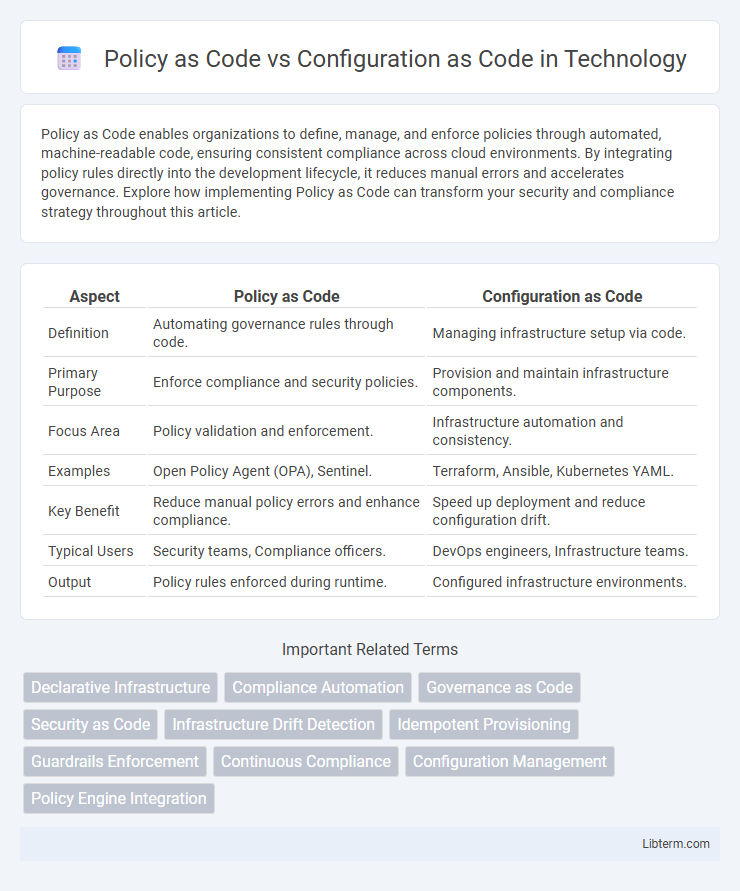Policy as Code enables organizations to define, manage, and enforce policies through automated, machine-readable code, ensuring consistent compliance across cloud environments. By integrating policy rules directly into the development lifecycle, it reduces manual errors and accelerates governance. Explore how implementing Policy as Code can transform your security and compliance strategy throughout this article.
Table of Comparison
| Aspect | Policy as Code | Configuration as Code |
|---|---|---|
| Definition | Automating governance rules through code. | Managing infrastructure setup via code. |
| Primary Purpose | Enforce compliance and security policies. | Provision and maintain infrastructure components. |
| Focus Area | Policy validation and enforcement. | Infrastructure automation and consistency. |
| Examples | Open Policy Agent (OPA), Sentinel. | Terraform, Ansible, Kubernetes YAML. |
| Key Benefit | Reduce manual policy errors and enhance compliance. | Speed up deployment and reduce configuration drift. |
| Typical Users | Security teams, Compliance officers. | DevOps engineers, Infrastructure teams. |
| Output | Policy rules enforced during runtime. | Configured infrastructure environments. |
Introduction to Policy as Code and Configuration as Code
Policy as Code automates the creation and enforcement of organizational policies using programmable rules, enabling consistent security and compliance across infrastructure. Configuration as Code refers to managing system settings and infrastructure deployments through machine-readable definition files, ensuring repeatability and version control. Both approaches streamline IT operations but focus respectively on enforcing governance (Policy as Code) and maintaining environment consistency (Configuration as Code).
Defining Policy as Code
Defining Policy as Code involves expressing governance rules and compliance requirements as machine-readable code, enabling automated policy enforcement and continuous monitoring within software development pipelines. Unlike Configuration as Code, which manages system settings and infrastructure configurations, Policy as Code emphasizes defining security, operational, and regulatory policies that ensure systems adhere to organizational standards. Implementing Policy as Code streamlines risk management by embedding policy validation directly into CI/CD workflows, reducing manual audits and policy violations.
Understanding Configuration as Code
Configuration as Code involves managing and provisioning infrastructure through machine-readable definition files, enabling automation and consistency across environments. This practice allows developers and operations teams to version control configurations, ensuring reproducibility and reducing errors in deployment processes. Emphasizing declarative syntax, Configuration as Code simplifies infrastructure scaling and accelerates continuous integration and delivery pipelines.
Key Differences Between Policy as Code and Configuration as Code
Policy as Code defines and enforces security, compliance, and governance rules programmatically to ensure systems adhere to organizational standards, while Configuration as Code manages infrastructure and application settings declaratively to automate deployment and environment consistency. Key differences include their primary focus, with Policy as Code centered on rule enforcement and compliance validation, contrasted with Configuration as Code's emphasis on system and software configuration management. Policy as Code frameworks like Open Policy Agent integrate seamlessly with CI/CD pipelines to provide real-time policy checks, whereas Configuration as Code tools such as Terraform or Ansible handle the provisioning and state management of resources.
Common Use Cases for Policy as Code
Policy as Code enables automated enforcement of compliance and security policies within software development pipelines, ensuring consistent governance across cloud infrastructures and applications. Common use cases span regulatory compliance checks, access control policy validation, and real-time vulnerability detection, helping organizations maintain security posture without manual intervention. This contrasts with Configuration as Code, which primarily focuses on managing and provisioning infrastructure and application settings through declarative definitions.
Typical Scenarios for Configuration as Code
Configuration as Code is typically used in scenarios such as infrastructure provisioning, application deployment, and environment setup where declarative definitions manage system states and automate repetitive tasks. It enables teams to version control system configurations, ensuring consistency across development, testing, and production environments. Examples include Kubernetes YAML manifests, Terraform scripts for cloud resources, and Ansible playbooks for server configurations.
Benefits of Adopting Policy as Code
Policy as Code enables organizations to automate governance by embedding compliance and security rules directly into software development workflows, reducing manual errors and accelerating audit processes. It provides real-time policy enforcement and consistency across cloud environments, enhancing risk management and regulatory adherence. Unlike Configuration as Code, which primarily manages infrastructure setup, Policy as Code focuses on defining and validating operational policies, ensuring continuous compliance throughout the deployment lifecycle.
Advantages of Configuration as Code Practices
Configuration as Code enhances deployment consistency by enabling automated, repeatable infrastructure setups, reducing human errors and drift. It improves collaboration across development and operations teams through version-controlled configurations, fostering transparency and faster troubleshooting. This practice accelerates scaling and updates, allowing rapid adaptation to changing requirements while ensuring compliance with organizational standards.
Challenges and Considerations in Implementation
Policy as Code implementation faces challenges in ensuring that policies are both comprehensive and flexible enough to adapt to evolving compliance requirements, often requiring continuous updates and validation against organizational standards. Configuration as Code demands precise synchronization between code repositories and deployment environments to prevent configuration drift and maintain system stability, necessitating robust version control and automated testing frameworks. Both approaches require strong collaboration between development, security, and operations teams to align governance with deployment workflows, emphasizing the need for standardized tools and processes to mitigate risks and improve auditability.
Choosing the Right Approach: Policy as Code vs Configuration as Code
Choosing between Policy as Code and Configuration as Code hinges on organizational priorities: Policy as Code enforces compliance and governance by codifying security policies and regulatory requirements, ensuring automated policy validation across infrastructure. Configuration as Code focuses on managing and provisioning system resources and application settings through version-controlled code, promoting consistency and repeatability in deployment processes. Evaluating whether your primary need is policy enforcement or infrastructure management guides the optimal approach for your DevOps strategy.
Policy as Code Infographic

 libterm.com
libterm.com